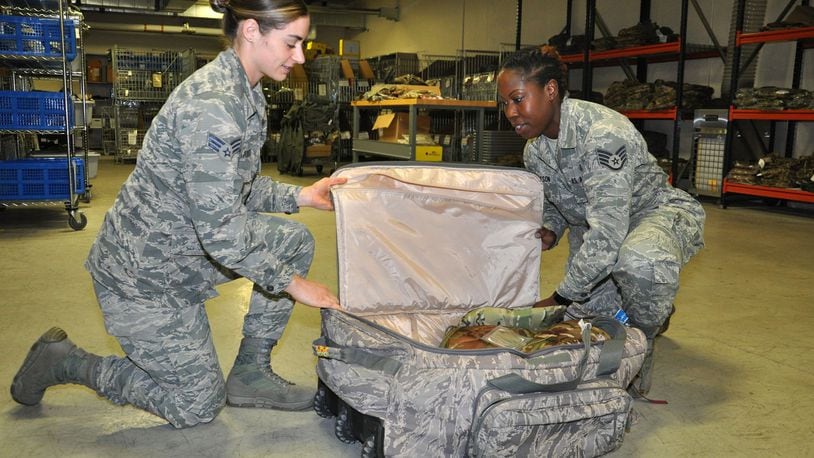Weary, in the superintendent position for almost a year now, arrived for duty at Wright-Patterson Air Force Base in November 2015 and began his tour at the medical center working in medical logistics.
“My role as superintendent is to ensure our individuals at the front lines have the resources, training and support they need to support our customers, whether it’s operational, aerospace medical squadron or dental, so they can deliver what we like to call trusted care, or patient-centered care,” Weary said.
With staffing of about 315 people, half active-duty and half civilian contractors, the squadron is comprised of six different flights and a command support section that is the focal point for administrative tasks such as officer and enlisted performance reports, military decorations, in/out processing actions and leave management, among many others.
The squadron’s Resource Management Office ensures needed resources such as labor, services and materials are obtained and used in the most economical manner. The office manages the funds for the medical center – as part of an approximate $138 million annual budget. They also provide Defense Travel System orders and manage the medical center’s Government Travel Card program.
The Medical Logistics Flight is the foundation of the medical treatment facility for how the facility operates, including medical supplies, contracts and 8,000 pieces of medical equipment valued at $80 million. Personnel here are also responsible for facility management, including vehicles assigned to the medical center.
Medical Readiness Flight personnel maintain the third-largest medical readiness account in the Air Force and are responsible for about 178 Unit Type Codes, consisting of about 1,200 personnel that are postured to deploy when required. Staff here support down-range readiness and emergency planning requirements at home station.
The Tricare Operations and Patient Administration Flight, or TOPA, is responsible for clinical and outpatient records, release of information, coding, Health Insurance Portability and Accountability Act considerations, and medical referrals and medical evaluation boards.
The Information Systems Flight is responsible for the Information Technology platform infrastructure of the medical center. They are the second-largest medical information system in the Air Force and are responsible for IT, cell phones and cyber readiness of the medical center.
“A medical support squadron’s mission is completed mostly behind the scenes,” said Hooper. “However, by leveraging strength through support we ensure the medical group’s clinical areas have the right supplies, equipment and space to provide world-class care to our patients,” he said.
“The squadron really is like a mini mission support group in the sense of what we provide. Our relationships extend far beyond our walls. When you look at our Guard and Reserve partners, to individuals throughout Wright-Patterson, from first aid kits to how we ensure resources are available for readiness exercises, there’s not an individual on this base who is not influenced by a product line that we support,” Weary said.
He said the squadron has a tremendous amount of effective, efficient and professional flight-level leaders who do a tremendous job, but that doesn’t mean junior personnel don’t have opportunities to excel as well.
“We have A1Cs coming right out of tech school who are responsible for multi-million dollar X-ray systems and those that are responsible for millions of dollars in acquisitions. We entrust them with a lot and they go through rigorous training,” said Weary.
Junior-level members also brief Hooper on their flight-level operations.
“These are opportunities that sometimes individuals in other organizations aren’t given until they’re Senior NCOs. So they’re being developed, understanding that language, building that confidence. Institutionally, they’re building self-awareness skills pertaining to how they’re able to interact and communicate, and this gives them the ability to see how they directly drive the mission,” Weary said.
“We also created what we call our Front Line Improving Customer Care Committee because so much of our support is driven by what our individuals do at the front lines. We want to create an adaptive learning environment where individuals at the front line are engaged with squadron-level leadership to communicate what they’re doing to improve customer service, what they’re doing to improve their processes, how they’re achieving their flight-level goals, and how they tie into the squadron, group and wing when it comes to our four major graded areas of accomplishing the mission,” he said.
According to Weary, based on inputs from the committee, at least 50 to 60 different process improvements have been made at the flight level that have improved how support is delivered for patient-centered care.
“There’s a misconception sometimes in the support environment that we don’t directly impact patient care. Everything we do supports the push and pull of services to patients. Our goal is to ensure that when patients come in, they have a beautiful, safe facility, where patients can find their locations, and whose care providers are focused on them.”
Photo captions:
170706-F-TH808-008.JPG:
Senior Airman Steve Alston, a personnel specialist with the 88th Medical Squadron’s command support section, checks a member’s records for information July 6. The squadron’s command support section is the focal point for administrative tasks such as officer and enlisted performance reports, military decorations, in/out processing actions and leave management, among many others. Alston has been assigned to the unit for about a year and a half. (U.S. Air Force photo/Bryan Ripple)
170706-F-TH808-010.JPG:
Senior Airman Emily Killingbeck, a unit deployment technician with the 88th Medical Support Squadron, and Staff Sgt. Jeria Dotson, medical readiness training manager, build up a deployment bag at the 88th Medical Readiness Squadron’s medical readiness warehouse July 6. (U.S. Air Force photo/Bryan Ripple)
About the Author
